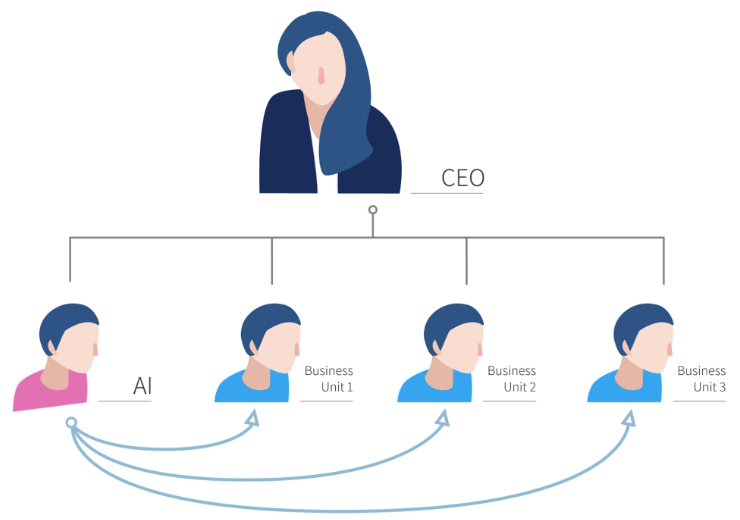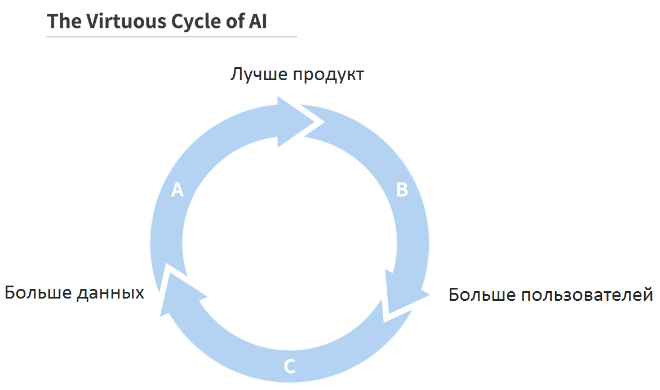Plan AI-transformation: how to manage a company in the era of AI?
We share with you another useful translation of the article . Also, those who have the desire to learn Best Practice in 3 months to introduce modern analytical tools necessary for promoting products and services in the digital space into projects are invited to familiarize themselves with the program of the professional course Big Data for Managers . So how do you manage a company in an AI era?

Today, artificial intelligence (AI) technology is ready to change all industries, just as it did electricity 100 years ago. According to estimates, in the period up to 2030, AI-technologies will lead to an increase in GDP of 13 trillion dollars. Although AI has already brought tremendous value in leading technology companies such as Google, Baidu, Microsoft, and Facebook, the big surge in creating value for business will be beyond the scope of the software development industry.
This AI Transformation Plan is based on the ideas of the Google Brain and Baidu AI Group, which played a leading role in transforming Google and Baidu into leading AI companies. Any company can follow this strategy and become a strong AI-company, although these recommendations are intended, first of all, for large enterprises with a market capitalization / estimate from 500 million to 500 billion dollars.
Here are the steps that are recommended for transforming your enterprise using AI:
- Run pilot projects to get quick results.
- Create your own AI team.
- Provide extensive AI training.
- Develop an AI strategy.
- Develop internal and external communications.
1. Run pilot projects to get quick results.
For your first AI projects, it is much more important that they are completed successfully than they are to be especially valuable. Projects should be quite significant so that the first successes help your company to get acquainted with AI, as well as convince others in your company to invest in further AI projects. They should not be so small that others find it trivial. It is important that the flywheel is spinning and your AI team can gain momentum.
For the first AI projects, the following characteristics can be offered:
- Ideally, a new or external AI team (which may not have deep knowledge of your business) should be able to collaborate with your internal teams (who have business knowledge) and create AI solutions that show results for 6-12 months.
- The project must be technically feasible. Too many companies are starting projects that cannot be implemented using modern technologies of artificial intelligence. Trusting the AI engineers to make a project check before the start, which will increase your confidence in its feasibility.
- You must have a clear and measurable goal that creates value for the business.
When I led the Google Brain team, there was considerable skepticism about deep learning in Google (and, more generally, worldwide). To help the team gain momentum, I chose the Google Speech team as my first internal client, and we worked closely with them to improve speech recognition in Google Speech. Speech recognition is a significant project in Google, but not the most important. For example, it is less important than the use of AI for searching the Internet or advertising. But by making the Speech team more successful with deep learning, other teams began to trust us, which allowed the Google Brain team to gain momentum.
As soon as other teams began to see the success of Google Speech working with Google Brain, we were able to attract more internal customers. The second major internal client was Google Maps, which used deep learning to improve the quality of map data. With two successful projects, I began negotiations with the advertising team. Increasing the pace gradually led to the emergence of more and more successful AI projects. The same process you can use in your company.
2. Create your own AI team
While outsourcing partners with extensive AI technical expertise can help you get an initial boost faster, in the long run it will be more efficient to carry out some projects with your own AI team. In addition, you may want to save some projects within the company to create a unique competitive advantage.
Hiring a CIO (CIO) in the period of increasing influence of the Internet has become an important point for many companies to develop a unified strategy for using the Internet. In contrast, companies that conducted many independent experiments — from digital marketing and data science experiments to launching new websites — could not use the power of the Internet when these small pilot projects could not scale to transform the rest of the company.
In the era of AI, the key moment for many companies will be the formation of a centralized AI team that can help the entire company. This AI team could be subordinated to a CTO, CIO or CDO (data director or digital technology director) if they have the right skill set. He can also be headed by a special CAIO (director of AI).
The main responsibilities of the AI unit:
- Create AI capabilities to support the entire company.
- Initiate initial cross-functional AI projects to support various departments. After completing the initial projects, set up recurring processes for the continuous delivery of valuable AI projects.
- Develop agreed standards for recruitment and retention.
- Develop corporate-wide platforms that will be useful for different departments and are unlikely to be developed by a separate department. For example, to collaborate with CTO / CIO / CDO to develop common standards for data warehousing (data warehouse).
Subdivisions in many companies are subordinate to the general director (CEO). With the new AI unit (AI), you will be able to apply AI talents to different units to implement cross-functional projects.

New posts and teams will appear. The way I now organize the work of my teams with such posts as a machine learning engineer (Machine Learning Engineer), data engineer (Data Engineer), data analyst (Data Scientist) and product manager of AI (AI Product Manager), different from the era preceding AI. A good AI leader can advise you on setting up the right processes.
Currently, there is a war for AI specialists, and, unfortunately, most companies will find it difficult to hire a graduate student at Stanford University (or perhaps even an undergraduate). Because in the short run the war of talents is largely zero. Working with a recruiting partner can help you create an AI team that will give you a non-trivial advantage. However, training your existing team can also be a good way to get many new professionals within the company.
3. Provide extensive AI learning
Today, no company has enough internal AI talent. And although the media talk about high salaries of AI specialists, often these salaries are too high (the figures given in the press, as a rule, are stuffing). AI specialists are hard to find. Fortunately, with the growth of digital content, including MOOC (Massive Online Open Courses, mass open online courses), such as Coursera, e-books and videos on YouTube, it is becoming more cost-effective to teach a large number of employees new skills, such as AI . The clever CLO (Chief Learning Officer, Chief Training Officer) knows that his job is not to create content, but to support and create processes that provide employees with training.
A decade ago, employee training meant bringing in consultants who came to your office to give lectures. But it was inefficient and the return on investment was unclear. In contrast, digital content is much more accessible and gives employees more personalized knowledge. If you have a budget for hiring consultants, then the work of consultants should complement online content. (In pedagogy, this is called “flipped classroom”. I found that when used correctly, this leads to faster and more fun learning. For example, at Stanford University my Deep Learning course is taught using this form of learning .) Hiring several experts on artificial intelligence to provide personalized content can help motivate your staff to study these AI techniques.
AI will change many activities. You must teach everyone what they need to adapt to new roles in the AI era. Consultation with an expert will allow you to develop an individual training plan for your team.
A conditional training plan might look like this.
Senior executives (⩾ 4 hours)
Objective: To enable managers to understand what AI can do for your enterprise, start developing an AI strategy, make decisions about resource allocation, and collaborate effectively with an AI team that supports valuable AI projects.
Training program:
- A basic understanding of AI in business, including basic technologies, data and what AI can and cannot do.
- Understanding the impact of AI on corporate strategy.
- Examples of application of AI in related industries or in your industry.
Heads of units involved in AI projects (⩾12 hours)
Objective: heads of departments should be able to determine the direction for AI projects, allocate resources, monitor and track progress, and also make adjustments as necessary to ensure the successful implementation of the project.
Training program:
- A basic understanding of AI in business, including basic technologies, data and what AI can and cannot do.
- Fundamentals of technical understanding of AI, including the main classes of algorithms and their requirements.
- Basic understanding of workflow and processes in AI projects, roles and responsibilities in AI teams, as well as management of the AI team.
AI engineers (⩾ 100 hours)
Objective: trained AI engineers should be able to collect data, train AI models and implement specific AI projects.
Training program:
- Deep technical understanding of machine learning (machine learning) and deep learning (deep learning); basic understanding of other AI tools.
- Understanding the available tools (open source and others) for building AI and data processing systems.
- Ability to implement workflows in an AI team.
- Optional: continuous learning to keep pace with the developing technology of artificial intelligence.
4. Develop an AI strategy
The AI strategy will guide your company to create value, as well as to build defenses. As teams begin to see the success of initial AI projects and form a deeper understanding of AI, you can identify the places where AI can create the most value and concentrate resources in these areas.
Some executives will think that developing an AI strategy should be the first step. In my experience, most companies will not be able to develop a thoughtful AI strategy until they have some basic experience in the field of AI, which they can get in steps 1-3. The way you build defenses also evolves with the AI.
Here are a few approaches:
Create several complex AI assets that are generally consistent with a consistent strategy. AI allows companies to create unique competitive advantages in a new way. Michael Porter's founding work on business strategy shows that one way to start a secure business is to create several complex assets that are generally consistent with a consistent strategy. Thus, it becomes difficult for a competitor to copy these assets at the same time.
Use AI to create an industry-specific advantage: instead of trying to compete “in general” in AI with leading technology companies like Google, I recommend instead becoming the leading AI company in your industry, where developing unique AI capabilities will allow you get a competitive advantage. How AI affects your company's strategy depends on the industry and situation.
Development of strategies in accordance with the cycle of positive feedback "Effective circle of AI" (Virtuous circle of AI): in many industries we will see the accumulation of data leading to a protected business:

For example, leading web search engines such as Google, Baidu, Bing, and Yandex have a huge resource of data that shows which links a user clicks on after various search queries. This data helps companies create more accurate search engines (A), which, in turn, help them attract more users (B), which in turn leads to even more user data ©. It is difficult for competitors to break into this cycle of positive feedback.
Data is a key asset for artificial intelligence systems. Thus, the largest AI companies also have a complex data strategy . Key elements of your data strategy may include:
Data collection. Useful artificial intelligence systems can be built using from 100 data units (“small data”) to 100,000,000 data units (“big data”). But having more data almost never hurts. AI teams use very complex multi-year data collection strategies, and specific data collection strategies depend on the industry and the situation. For example, Google and Baidu have many free products that are not monetized, but allow them to receive data for profit in other places.
Unified data warehouses: if you have 50 different databases under the control of 50 different managers or departments, it will be almost impossible for an engineer or AI software to access this data and find a connection between them. Instead, consider centralizing data in one or a small number of data warehouses.
Determine which data is valuable and which is not: mistakenly thinking that having a large amount of terabytes of data automatically means that the AI team can benefit from this data. Waiting for the AI team to magically create value from a large data set is a formula that has a high probability of failure. And I have seen tragic cases when CEOs have invested heavily in collecting low-value data or even acquired a company for its data, only to realize that many terabytes of data from the target company were useless. Avoid this error by attracting an AI command at the beginning of the data collection process, and let them help you prioritize which types of data to collect and store.
Create a network effect and platform advantage. Finally, AI can also be used to create more traditional defenses. For example, platforms with a network effect are a business with a high degree of protection. They often have a natural “winner takes all” dynamic that drives companies to grow quickly or die. If AI allows you to attract users faster than your competitors, then it can be used to create protection that works through platform dynamics. In a broader sense, you can use AI as a key component of a low-cost, high-value strategy, or other business strategies.
5. Develop internal and external communications.
AI will significantly affect your business. You must inform the AI of all key stakeholders, to the extent that it affects their interests. Here is what you should take into account for each audience:
Investor Relations: Leading AI companies such as Google and Baidu are currently much more expensive companies, in part because of their AI capabilities and the influence that AI has on their income. Explaining how AI creates value for your company and describing your growing AI capabilities along with a well-thought-out AI strategy will help investors evaluate your company correctly.
Relations with the state: companies in highly regulated industries (unmanned vehicles, healthcare) face unique challenges to stay within the law. Developing a credible and convincing story explaining the value and benefits that your AI project can bring to the industry or society is an important step in building trust and goodwill. .
: , , , , .
/ : - - . - . , , .
: , (Artificial General Intelligence) , , . , , (, , ). , , .
,
, , . , , , , , . , :
« + ≠ -»
- -, -. -: , , ?
, - A/B-, - , . - , . - , , , , . - , , , .
(deep learning), , . , :
« + Deep Learning ≠ -»
, , , .
, :
- -: - / -, .
- . -.
- : , .
- , . 2-3 , 6-12 . -, .
')
Source: https://habr.com/ru/post/448560/
All Articles